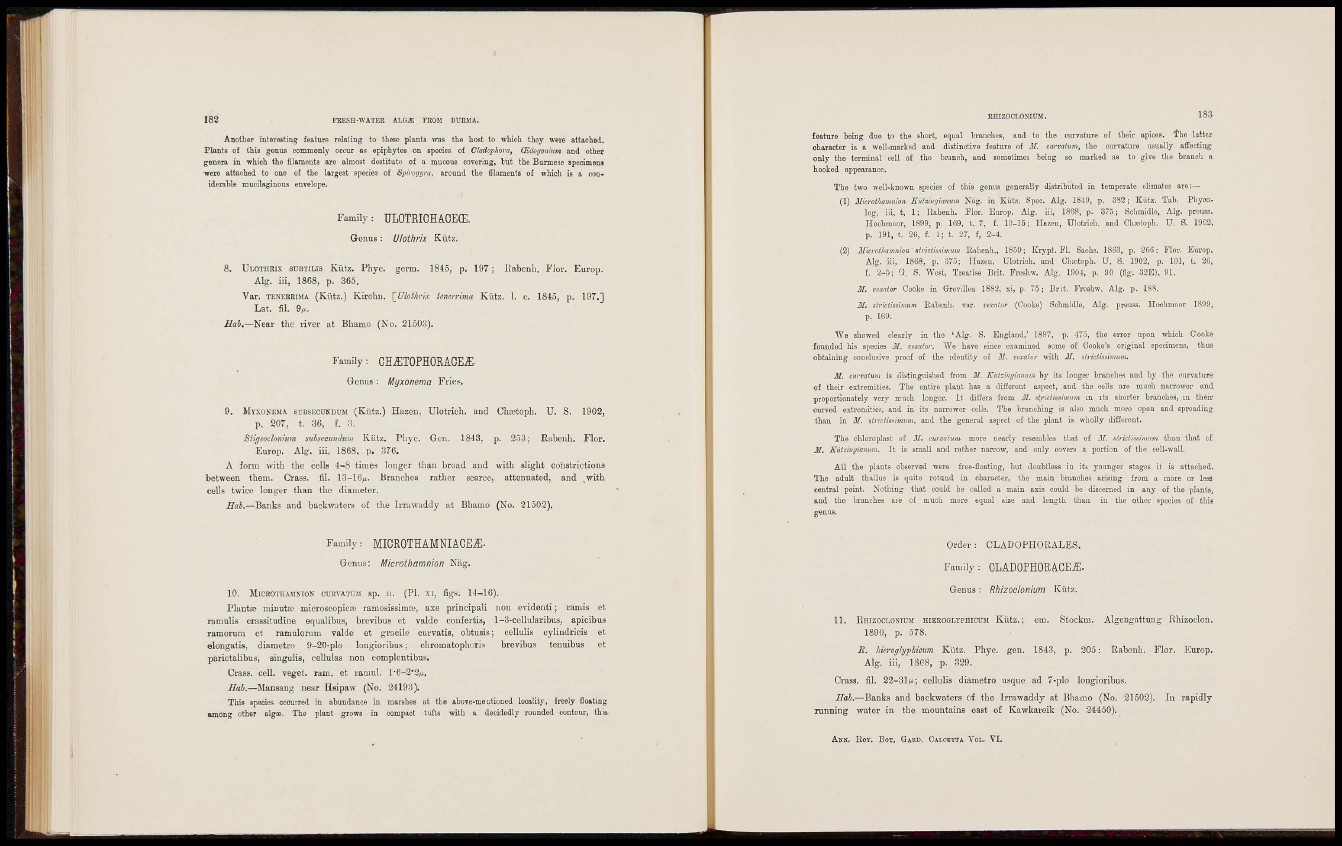
182 FEESH-WATER AT.G^ FROM BURMA.
Anotlier intereiting feature relating to tkeee plants was the host to which they were attached.
Plants of this genus commonly occur as epiphytes on species of Cladophora, CBdogontum and other
genera in which the filaments are almost destitute of a mucous covering, tut the Burmese specimen»
wer« attached to one of the largest species of Spirogr/ra, arouud the filaments of which is a coniderable
mucilaginous envelope.
Family : ULOTEIOHACEiE.
Genus : UlothHx Kütz.
8. ULOTHHIX SUBTILIS Kiitz. Phyc. germ. 1845, p. 1 9 7 ; Kabeuh. Flor. Europ.
Alg. iii, 1868, p. 365.
Var. TENEBRiMA (Kütz.) Kirchn. [_Ulotkrix tcncnima Kütz. 1. c. 1845, p. 197.3
L a t . fil. 9M.
i f a i . — N e a r the river at Bhamo (No. 21503).
Family : CHiETOPHORAOE^.
Genus : Myxonema Fries.
9. MYXONEMA SUBSECUNDUM (Kiltz.) Hazeii. Ulotrich. and üba?topb. U. S. 1902,
p. 207, t. 36, f. 3.
ßtigeoclonhm subseaundum Kütz. Phyc. Gon. 1843, p. 253; Rabenh, Flor.
Europ. Alg. iii, 1868, p. 376.
A form with the cells 4 - 8 times longer than broad acd with slight cohstrictiona
between them. Crass, fil. 13-16^. Branches rather scarce, attenuated, and .with
cells twice longer than the diameter.
iTfii.—Banks and backwaters o£ the Irrawaddy at Bhamo (No. 21502).
F a m i l y : MIGROTHAMNIACEi;-
Genus: Microthamnion Näg.
10. MlCEOTHAMNIOy CURVATUil Sp. B. (PI, XI, figS. 14-16).
Planta? minuta; microscopica? ramosäissimte, axe principali non evidenti ; ramis et
ramulis crassitudine equalibus, brovibus et valde confertis, l-ö-cellularibus, apicibus
ramorum et ramuloruni valde et gracile curvatis, obtusis; cellulis cylindricis et
elongatis, diametro 9-20-plo longioribus ; chromatophoris brevibus tenuibus et
parietalibus, singulis, cellulas non complentibus.
Crass, cell. veget. ram. et ramul, l-6-2'2p..
//ai.—Mansang near Hsipaw (No. 24193).
Tbis species occurred in abundance in marshes at the above-me tt io a ed locality, freely floating
among other algse. The plant grows in compact tufts with a decidedly rounded contour, thi&
RHIZOCLONIUM. 183
feature being due to the short, equal branches, and to the curvature of their apices, the latter
oharaoter is a well-marked and distinctive feature of M. cuna/um, the curvatiire usually aSecting
only the terminal cell of the branch, and sometimes being so marked as to give the branch a
hooked appearance.
The two woll-known species of this genus generally distributed in temperate climates are:—
(1) Mcrofiamnion Kiitsingianum Niig. in Kiitz. Spec. Alg, 1849, p. 382; Kutz. Tab. Phyoolog.
iii, t, 1; Eabenh. Flor. Europ. Alg. iii, 1868, p. 375; Sclimidle, Alg. proass.
I-Iochmcor, 1899, p. 169, t. 7, f. l l i - l S ; Hazeu, Ulotrich. and Chaitoph. U. S. 1902,
p. 191, t. 26, f. 1; t. 27, f, 2-4.
(2) Microthamnion etrictissimum Rabenb., 1859; Krypt. FI. Sachs. 1863, p. 266; Flor. Europ.
Alg. iii, 1868, p. 375; Hazen, Ulotrioh. and Chiotoph. U. S. 1902, p. 191, t. 2G,
f. 2-5; S, S. "West, Treatise Brit. Presliw. Alg, 190i, p. 90 (fig. 32E), 91.
G-revillea 1882, xi, p. 75; Brit, Freshw. Alg, p. 18«.
[ir. vexaior (Cooke) Schmidle, Alg, preuss. Hoobmoor 1899,
M. vexnior Cooke i
M, strktissimum Rabenh.
p. 169.
We showed clearly in. the 'Alg. S. England,' 1897, p. 475, the error upon which Cooke
founded bis species 31. vexaior. "We bave since examined some of Cooke's original specimens, thus
obtaining conclusive proof of the ideotity of M. vexator with J/, slyictissimum.
M. curvatum is distinguished from M. Kiils-'ngianvm by its longer branches and by the curvature
of their estremities. The entire plant has a different aspect, aud the celts are much narrower and
proportionately very irncb longer. It differs from M. st,riclismnin> in its sliorter branches, in their
curved estreCiities, and in its narrower cells. The branching is also much more open and spreading
than in M. sirictissmum, and the general aspect of the plant is wholly different.
The chloroplast of M. curvatum more nearly resembles that of M. sirktissimum than that of
JU. KHUingiamm. It is small and rather narrow, and only covers a portion of the cell-wall.
All the plante observed were free-floating, but doubtless in its younger stages it is attached.
The adult thallus is quite rotund in cnaracter, the main branches arising from a more or less
central point. Nothing that could be called a main axis could be discerned in any of the plantsj
and the branches are of much more equal size and length than in the other species of this
Order : CLADOPHORALES.
F a m i l y : OLADOPHORACB^.
Genus : Rhizoclonium Kutz.
11. EHIZOCLOSIDM HIEEOGLYPHICUM Kutz. ; era. Stockm. Algengattung Rhizoclon.
1 8 9 0 , p. 5 7 8.
li. Mcroglypliicum Kiitz. Phyc. gen. 1843, p. 205 : Rabenh. Fior. Europ.
Alg. iii, 1368, p. 329.
Crass, fil. 22-31M; cellulis diametro usque ad 7-plo longioribus.
iZai.—Banks and backwaters of the Irrawaddy at Bhamo (No. 21502). In rapidly
running water in the mountains east of Kawkareik (No. 34450).
AHN. ROY. BOT. GARD. CALCUTTA VOL. VI.